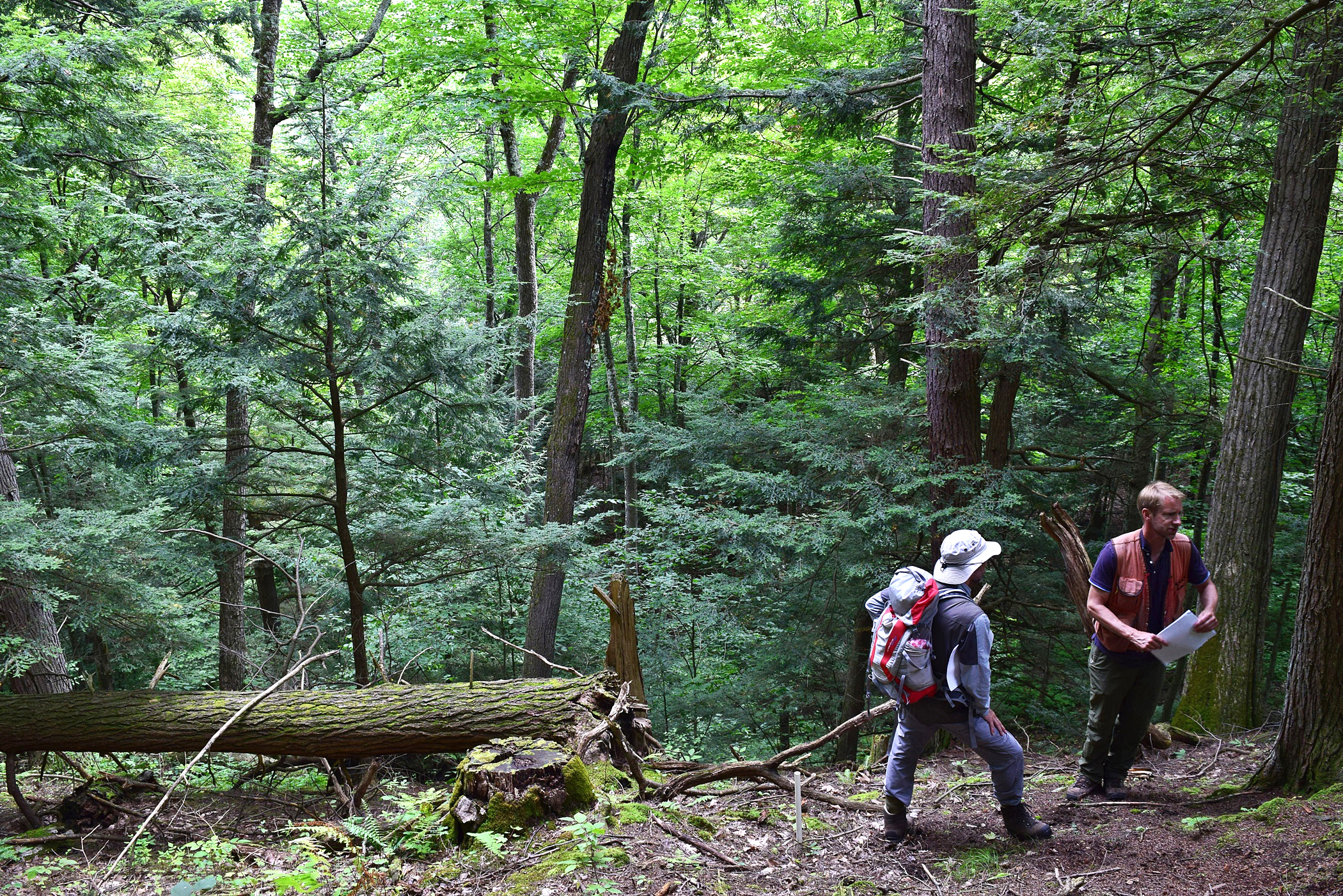Managing Forests for Old Growth Traits Enhances Biodiversity and Carbon Storage
Apr. 22nd 2018The traditional concept of an old growth forest conjures visions of tall, stately trees; massive, moss-covered logs; and a forest floor teeming with understory plants, animals, and other organisms. Researchers at the University of Vermont experimented to see if they could accelerate the development of old growth conditions in secondary forests. Their goal was to enhance carbon storage as a way to help fight climate change, while generating modest revenue through timber harvest.
In 2001, researchers in the Rubenstein School of Environment and Natural Resources established the Vermont Forest Ecosystem Management Demonstration Project on two sites in northern Vermont, one on the Mount Mansfield State Forest and one on the University’s Jericho Research Forest. At these sites, Professor Bill Keeton and his students tested a type of natural disturbance-based silviculture, a forest management approach that emulates natural disturbances, such as windstorms, and helps to manage for late-successional or old growth structure.
Keeton and his team used a natural disturbance-based method they call “structural complexity enhancement” (SCE) to increase the intricacy of the vertical and horizontal arrangement of trees and plants, both living and dead. Forest stands with more complex architecture, containing trees of all ages and sizes, are more resilient and provide valuable habitat for a greater diversity of plants and animals than do stands with less structural complexity.
These new approaches to forest management have also gained attention because of their potential for maintaining high levels of forest biomass and carbon storage. Voluntary and compliance carbon markets, such as the California Air Resource Board Cap-and-Trade Program or the American Carbon Registry, increasingly incentivize, or pay, forest landowners to maintain greater volumes of standing, carbon-storing timber to offset greenhouse gas emissions.
In 2003, university researchers implemented three different timber harvest treatments on their study sites: SCE and conventional single-tree selection and group-tree selection harvests. In the SCE treatments, loggers thinned around larger trees to provide them more growing space in the canopy. They left more large logs on the ground, girdled trees to create snags, or dead standing trees, and pulled down others to form tip-up mounds.
A decade later, Keeton and graduate student Sarah Ford found that SCE treatments in these northern hardwood-conifer forests resulted in greater biomass production and carbon storage compared to conventional selection harvests. Carbon storage in the SCE treatments was only slightly less than simulated no-harvest baselines and substantially greater than in the selection treatments. Total aboveground carbon storage in SCE plots was nearly 16 percent less than that projected using a computer model for no-treatment, compared to 45 percent less in conventionally treated areas. Surprisingly, tree growth rates were also slightly higher under SCE.
The greatest increases in carbon storage occurred in coarse woody material on the ground. SCE treatments contained just over 12 metric tons per hectare of carbon in coarse woody material compared to just over 6 metric tons per hectare in conventional treatments and just over 8 metric tons per hectare in areas with no treatment.
Earlier work on the Forest Ecosystem Demonstration Project had shown that SCE enhances elements of late-successional biodiversity, such as salamanders, herbaceous plants, and fungi, while also generating a modest profit from timber harvest under the right site and market conditions. But, a major uncertainty was whether tree regeneration would be sufficient for practical use.
Keeton and a second graduate student, Aviva Gottesman, found that SCE was successful at recruiting saplings for a diversity of tree species and at sufficient densities for adequate growth and yield. Regeneration included more economically desirable species, such as sugar maple and yellow birch. But, as many foresters in the region have experienced, competition with American beech sprouts was fierce, though actually less severe than under group selection. Regeneration was patchy for all species, with prolific beech sprouts dominating in some patches under all the treatments. While SCE generally fosters abundant regeneration of important late-successional tree species, depending on site conditions, control of beech is recommended where it inhibits desired regeneration.
The researchers recommend SCE treatments as an effective approach for northeastern landowners to increase carbon storage in managed northern hardwood forests and as an option for capturing supplemental revenue from rapidly developing compliance and voluntary carbon markets. Natural disturbance-based silviculture offers an alternative for sustainable management, providing multiple co-benefits, including climate change mitigation, late-successional forest structure and habitat, and lower intensity timber harvest. Tree regeneration is sufficient for long-term sustainability of these co-benefits. Working forests can accrue additional revenue, which encourages sustainable forest management and woodland conservation.
 ecoNEWS VT
ecoNEWS VT